How to Create A Robust Hybrid Work Policy – The Complete Guide
6 min read
Need help to create a robust hybrid work policy? You’re in the right place!
In this post, we show you how to create a robust hybrid work policy.
The COVID-19 pandemic forced many businesses to close their offices. Many adopted work-from-home arrangements to keep their operations going.
While remote work arrangements were meant to help companies cope with the pandemic, they turned out to be successful for most companies. In fact, it was so successful that 74% of companies expect remote work to become standard even after the pandemic ends.
Adopting a hybrid work model is becoming increasingly necessary and can benefit your company in many ways.
But before you implement a hybrid work model, you need to roll out a policy to facilitate it.

What is the Hybrid Work Model?
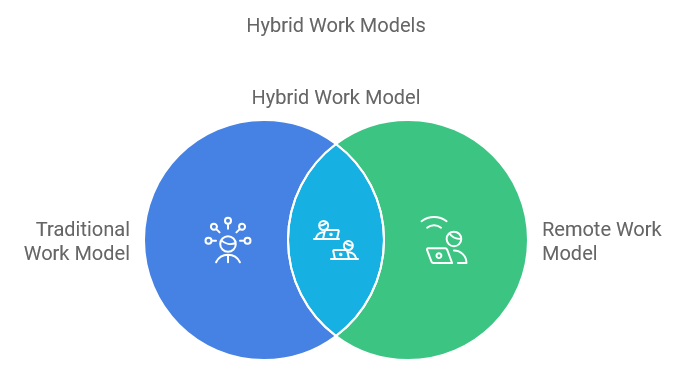
The hybrid work model is a work arrangement that involves combining the traditional work model (working at the office) with a remote work model. It can take three forms:
- Some employees work on-site full-time, while others work remotely full time.
- All employees work partly at the office and partly from home during alternating days of the week (or alternating weeks).
- Employees can choose whether and when to work on-site or from home (essentially a combination of the two models discussed above).
The exact details of your company’s hybrid work model will depend on the nature of your business and its most pressing needs and preferences. However, it is worth noting that some occupations cannot support hybrid work models because the employee must be on site to accomplish the task.
The Need for a Hybrid Work Policy
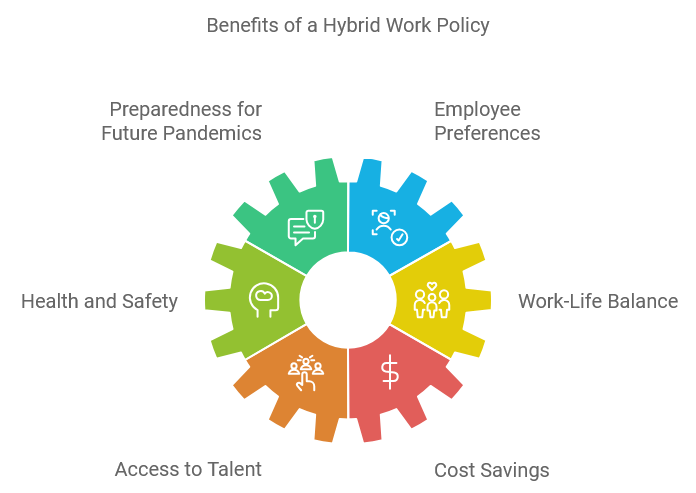
The pandemic appears to be easing, so why does your company need a hybrid work policy? While there are dozens of reasons supporting long-term hybrid work models, some of the most convincing include:
It Pays to be Prepared
Working from home became a necessity during the worst phases of the COVID-19 pandemic. The pandemic has been easing, but it is unpredictable and could get worse again in the future.
There also exists the likelihood of another outbreak as bad as (or worse than) the coronavirus. If (and when) that happens, companies will need a ready hybrid work policy and infrastructure.
As such, the pandemic’s end doesn’t necessarily mean an end to remote and hybrid work models. Instead, it is more prudent for companies to refine their hybrid work policies and infrastructure to support a remote-first culture.
Employees Prefer Hybrid Work Models
Most employees who worked from home because of the pandemic liked the experience. They wish that it would continue, regardless of whether there is a pandemic.
A recent study by FlexJobs shows that 58% of employees prefer working from home full-time. Another 39% prefer a hybrid work model whereby they work partly from home and partly on-site.
Coincidentally, employees across many industries are resigning at an unprecedented rate in what has been dubbed “The Great Resignation.” It wouldn’t be surprising if some decided to resign if the company did not have a hybrid work policy.
Improving Employees’ Health & Safety
The COVID-19 pandemic is the main reason behind the recent mass adoption of work-from-home and hybrid work models. Allowing employees to work from their homes’ safety reduced the virus’ spread.
The virus is still a present threat, and there is a notable likelihood of another virus outbreak. A hybrid work model will help you keep your employees healthy throughout this and any other pandemic.
Better Work-Life Balance for Your Employees
The ability to strike a better work-life balance is the main reason behind many employees’ push for the flexibility to work remotely.
Your employees will be able to spend more time with their loved ones and attend to their private affairs when working remotely. This will benefit your business, too, by improving your employees’ productivity.
Access to a Larger Talent Pool
The remote work model essentially entails working from anywhere, not necessarily only from home. This means that your company can hire employees from virtually anywhere in the world, effectively maximizing your access to talent.
Saving on Real Estate
Do you need as much office space as you have now if half of your employees will be working from home?
Unsurprisingly, many companies are renting smaller office spaces. You, too, could lower your real estate costs by as much as 30%.
Elements of an Efficient Hybrid Work Policy
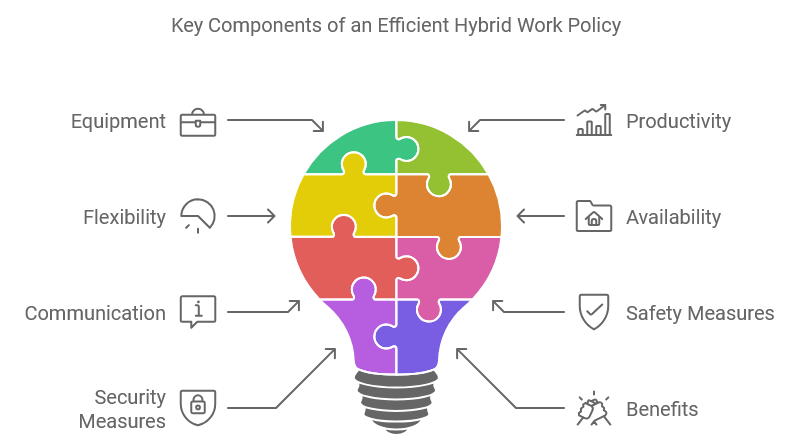
An efficient hybrid work policy should cover every element of your business and its operations. Some of the standard elements of an efficient hybrid work policy include:
- Equipment – Which tools and equipment will your employees need to work efficiently from home?
- Productivity – How will you measure your work-from-home and remote employees’ productivity versus those working in the office?
- Flexibility – How do work hours differ for on-site employees versus employees working from home?
- Availability – How does the company decide which employees work from home or office?
- Communication – How will employees working from home and on site exchange ideas (will communication be done in-person, remotely, or in both ways)? We put together a post on how you can ensure effective remote team communication.
- Safety Measures – What measures will your company take to protect employees working on-site against the coronavirus (for example, will they be required to wear masks and maintain social distancing)?
- Security Measures – What measures will your company take to protect all employees (including those working from home and on-site) from other threats besides the coronavirus?
- Benefits – will benefits differ for on-site employees versus employees working remotely?
- Dress Code – Are employees working from home required to adhere to the company’s official dress code?
It is worth noting that these are the standard elements for most hybrid work models. Ideally, your company’s model should include as many elements as needed to satisfy its unique needs and develop a reliable and efficient model.
Tools to Help You Develop & Implement a Hybrid Work Policy
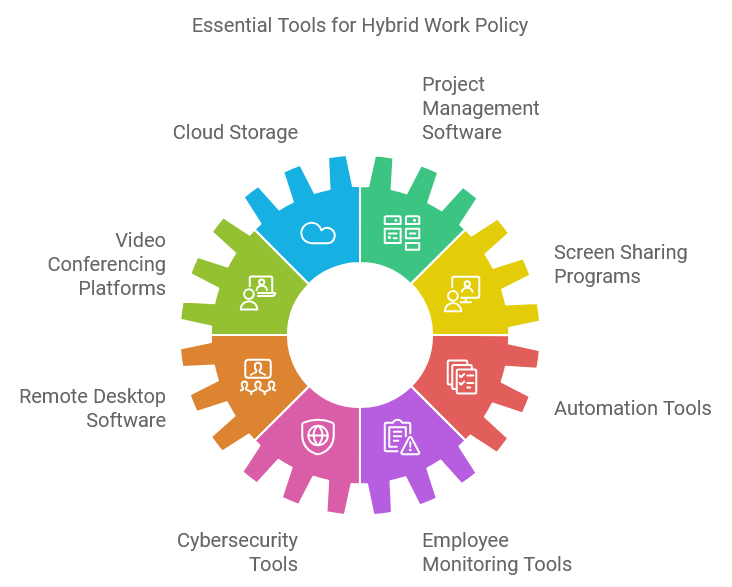
Formulating a hybrid work model for your company is only a fraction of the work needed to develop an efficient and reliable hybrid work infrastructure. Implementing the policy is where most of the work lies, and you need the right tools to get it done.
Here is an overview of seven types of tools that will help you develop and implement the various elements and facets of your hybrid work policy:
Cloud Storage
Cloud storage platforms store your data on the cloud, which is accessible from anywhere. You can give your employees access to the company’s cloud storage platform, enabling them to access the data needed to work on their projects from anywhere.
Project Management Software
Do your employees know their duties and tasks when they check in at the office or from home? Project management software is designed to help you manage every aspect of a project, including assigning tasks to different employees and monitoring their progress. Project management tools also provide visibility into your work-from-home and remote employees.
Video Conferencing Platforms
Communication is one of the elements of an efficient hybrid work policy. Everyone, regardless of whether they are working on site or from home, should be able to communicate with each other as if they were in the same room. Video conferencing platforms such as Zoom and MS Teams facilitate real-time face-to-face communication from anywhere in the world.
Screen Sharing Programs
Employees don’t need to be in the same room to make visual demonstrations of whatever they are doing. Screen sharing programs enable users to show other users exactly what is on their screens in real-time, making it easier for remote teams to collaborate on projects.
Remote Desktop Software
While all employees working from home have PCs, the IT support team may need access to their computers to solve technical issues. Remote Desktop Software enables them to access an employee’s computer securely from anywhere and troubleshoot issues.
Automation Tools
Many companies were automating their activities before the COVID-19 pandemic hit. Interestingly, remote work models also facilitate automation, which saves a lot of time and work.
Cybersecurity Tools
Remote work involves exchanging sensitive company data via the internet, which poses a cybersecurity risk. As such, all the company’s digital tools and platforms should be secured against cyberattacks using reliable cybersecurity tools and policies.
Employee Monitoring Tools
Some employees may take advantage of remote work arrangements to not work as much as they would in the office. Employee monitoring tools such as HiveDesk are designed to help you determine what your employees are doing whenever they are on the clock. These tools bring accountability into your hybrid team.
Sample Hybrid or Remote Work Policy Template
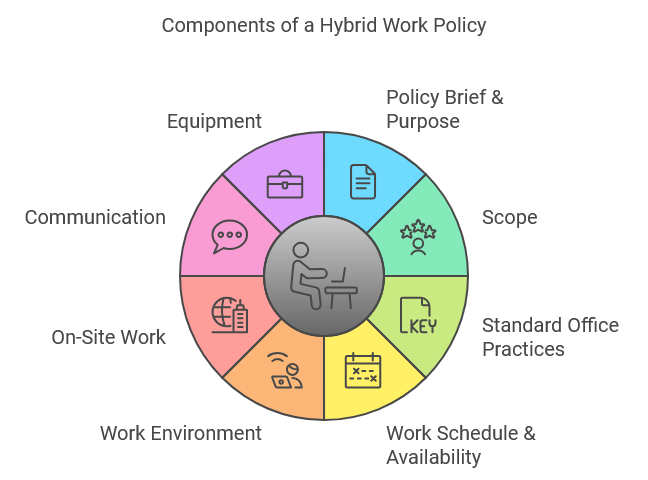
As explained earlier, a hybrid or remote work policy should cover every aspect of your business’ operations. Here is a brief overview of a sample, generic hybrid work policy template:
- Policy Brief & Purpose – This section contains a brief but informative summary of the policy and its functions.
- Scope – This section contains an informative description of which employees the policy applies to and how it applies to them.
- Standard Office Practices – This section contains a detailed list of rules and regulations that remote and on-site employees must follow.
- Work Schedule & Availability – This section details the work hours for all employees. Time tracking is an important aspect of people working outside the office. Many countries make it mandatory for businesses to track how much time employees spend on work. We put together a great resource on time tracking regulations around the world.
- Work Environment – This section contains a detailed guideline directing how remote employees should maintain their workspaces and environments. Here is a useful guide on what to include in an ideal work-from-home setup.
- On-Site Work – This section contains detailed directions of the procedures that all employees (especially remote employees) must follow when working on-site.
- Communication – This section contains instructions about the company’s preferred communication channels for on-site and remote employees.
- Equipment – This section contains a detailed overview of the hardware and software tools the company will provide on-site and remote employees.
- Security – This section contains detailed guidelines on how the company will secure sensitive data, including employees’ responsibilities towards security.
Ideally, your company’s hybrid work policy template should feature these and other relevant elements. It should also be flexible in responding to the increasingly dynamic changes in the workplace and the industry.
Here is the largest collection of remote work resources where you can find tools, blogs, guides and books to help you create your hybrid and remote work policy.
Conclusion
A hybrid work model is in almost every company’s future, regardless of the pandemic. This is an opportune time to develop your company’s hybrid work model, and these policy guidelines will help you through most of the process. You will also need tools to help you implement your model and manage your remote employees.
HiveDesk is a time-tracking tool for employers managing remote employees. Start your free trial today to see how HiveDesk can help you monitor and manage your remote employees.
